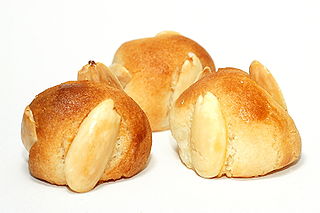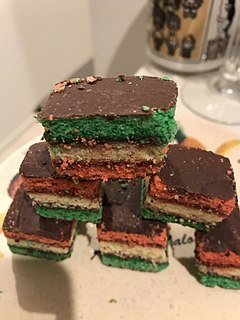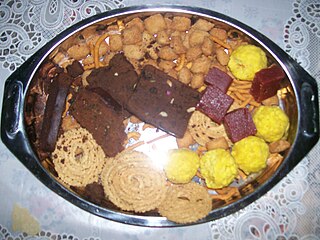
Lebkuchen, Honigkuchen or Pfefferkuchen, are a honey-sweetened German cake molded cookie or bar cookie that has become part of Germany's Christmas traditions. It is similar to gingerbread.

Pound cake is a type of cake traditionally made with a pound of each of four ingredients: flour, butter, eggs, and sugar. Pound cakes are generally baked in either a loaf pan or a Bundt mold. They are sometimes served either dusted with powdered sugar, lightly glazed, or with a coat of icing.

Gingerbread refers to a broad category of baked goods, typically flavored with ginger, cloves, nutmeg, and cinnamon and sweetened with honey, sugar, or molasses. Gingerbread foods vary, ranging from a soft, moist loaf cake to something close to a ginger snap.

Rice pudding is a dish made from rice mixed with water or milk and other ingredients such as cinnamon, vanilla and raisins.

Christmas cookies or Christmas biscuits are traditionally sugar cookies or biscuits cut into various shapes related to Christmas.

Jul or jol is the term used for the Christmas holiday season in Scandinavia and parts of Scotland. Originally, "jul" was the name of a month in the old Germanic calendar. The concept of "jul" as a period of time rather than a specific event prevailed in Scandinavia; in modern times, "Jul" is a period of time stretching from the fourth sunday before Christmas Eve, December 24, to (traditionally) mid-January at the date of Epiphany with the month of December and Christmas, and the week up to the New Year, as its highlight. The modern English yule and yuletide are cognates with this term.

Springerle is a type of South German biscuit or cookie with an embossed design made by pressing a mold onto rolled dough and allowing the impression to dry before baking. This preserves the detail of the surface pattern. While historical molds show that springerle were baked for religious holidays and secular occasions throughout the year, they are now most commonly associated with the Christmas season.

Bethmännchen is a pastry made from marzipan with almond, powdered sugar, rosewater, flour and egg. It is a traditional cookie usually baked for Christmas Day and is widely available in chocolate shops around Frankfurt.

Rosette cookies are thin, cookie-like fritters made with iron molds that are found in many cultures. The name rosettbakkels comes from Norwegian. Rosettes are crispy and typified by their lacy pattern. Rosettes are traditionally made during Christmas time. Rosette recipes are popular in the United States among families with Scandinavian ancestry.

Rainbow cookie or rainbow cake usually refers to a three-layered almond-flavored Italian-American cookie, but can also refer to any of a number of rainbow-colored confections.

Kuswar or Kuswad is a set of festive sweets and snacks made and exchanged by Christians of the Konkan region in the Indian subcontinent for the Christmas season or Christmastide. These goodies are major parts of the cuisines of the Goan Catholic community of Goa, and the Mangalorean Catholic community of Karnataka. There are as many as 22 different traditional recipes that form this distinct flavour of Christmas celebration in Goa and Mangalore.

Russian tea cake is a kind of pastry, often eaten around Christmas in the United States.

Jumbles are simple butter cookies made with a basic recipe of flour, sugar, eggs, and butter. They can be flavored with vanilla, anise, or caraway seed used for flavoring, or other flavoring can be used like almond. They were formerly often made in the form of rings or rolls.

Sponge cake is a light cake made with egg whites, flour and sugar, sometimes leavened with baking powder. Sponge cakes, leavened with beaten eggs, originated during the Renaissance, possibly in Spain. The sponge cake is thought to be one of the first of the non-yeasted cakes, and the earliest attested sponge cake recipe in English is found in a book by the English poet Gervase Markham, The English Huswife, Containing the Inward and Outward Virtues Which Ought to Be in a Complete Woman (1615). Still, the cake was much more like a cracker: thin and crispy. Sponge cakes became the cake recognized today when bakers started using beaten eggs as a rising agent in the mid-18th century. The Victorian creation of baking powder by English food manufacturer Alfred Bird in 1843 allowed the addition of butter to the traditional sponge recipe, resulting in the creation of the Victoria sponge.

Qurabiya is a shortbread-type biscuit, usually made with ground almonds. Versions are found in most countries of the Arab world, with various different forms and recipes.

Butter cookies, otherwise known as Danish biscuits, are cookies originating in Denmark consisting of butter, flour, and sugar. Originating in Denmark, they are similar to shortbread cookies.

Barquillo is a crispy rolled wafer pastry originating in Spain. It is made from the basic cookie ingredients of flour, sugar, egg whites and butter rolled out thinly and then shaped into a hollow cylinder or a cone. It was traditionally sold by roadside vendors known as barquilleros who carried a characteristic red roulette tin. It was introduced to Latin America and the Philippines during colonial times. In Spain and former Spanish colonies, barquillos are commonly regarded as a type of Christmas cookie. It is also popular during various fiestas. It spread to neighboring countries and today is extremely popular in East and Southeast Asian countries.
An almond biscuit, or almond cookie, is a type of biscuit that is made with almonds. They are a common biscuit in many different cuisines and take many forms.


















